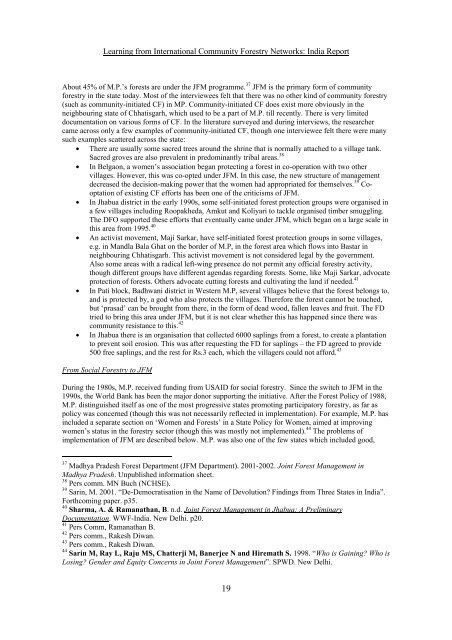Snapshots of International Community Forestry Networks: Country ...
Snapshots of International Community Forestry Networks: Country ...
Snapshots of International Community Forestry Networks: Country ...
You also want an ePaper? Increase the reach of your titles
YUMPU automatically turns print PDFs into web optimized ePapers that Google loves.
Learning from <strong>International</strong> <strong>Community</strong> <strong>Forestry</strong> <strong>Networks</strong>: India Report<br />
About 45% <strong>of</strong> M.P.’s forests are under the JFM programme. 37 JFM is the primary form <strong>of</strong> community<br />
forestry in the state today. Most <strong>of</strong> the interviewees felt that there was no other kind <strong>of</strong> community forestry<br />
(such as community-initiated CF) in MP. <strong>Community</strong>-initiated CF does exist more obviously in the<br />
neighbouring state <strong>of</strong> Chhatisgarh, which used to be a part <strong>of</strong> M.P. till recently. There is very limited<br />
documentation on various forms <strong>of</strong> CF. In the literature surveyed and during interviews, the researcher<br />
came across only a few examples <strong>of</strong> community-initiated CF, though one interviewee felt there were many<br />
such examples scattered across the state:<br />
• There are usually some sacred trees around the shrine that is normally attached to a village tank.<br />
Sacred groves are also prevalent in predominantly tribal areas. 38<br />
• In Belgaon, a women’s association began protecting a forest in co-operation with two other<br />
villages. However, this was co-opted under JFM. In this case, the new structure <strong>of</strong> management<br />
decreased the decision-making power that the women had appropriated for themselves. 39 Cooptation<br />
<strong>of</strong> existing CF efforts has been one <strong>of</strong> the criticisms <strong>of</strong> JFM.<br />
• In Jhabua district in the early 1990s, some self-initiated forest protection groups were organised in<br />
a few villages including Roopakheda, Amkut and Koliyari to tackle organised timber smuggling.<br />
The DFO supported these efforts that eventually came under JFM, which began on a large scale in<br />
this area from 1995. 40<br />
• An activist movement, Maji Sarkar, have self-initiated forest protection groups in some villages,<br />
e.g. in Mandla Bala Ghat on the border <strong>of</strong> M.P, in the forest area which flows into Bastar in<br />
neighbouring Chhatisgarh. This activist movement is not considered legal by the government.<br />
Also some areas with a radical left-wing presence do not permit any <strong>of</strong>ficial forestry activity,<br />
though different groups have different agendas regarding forests. Some, like Maji Sarkar, advocate<br />
protection <strong>of</strong> forests. Others advocate cutting forests and cultivating the land if needed. 41<br />
• In Pati block, Badhwani district in Western M.P, several villages believe that the forest belongs to,<br />
and is protected by, a god who also protects the villages. Therefore the forest cannot be touched,<br />
but ‘prasad’ can be brought from there, in the form <strong>of</strong> dead wood, fallen leaves and fruit. The FD<br />
tried to bring this area under JFM, but it is not clear whether this has happened since there was<br />
community resistance to this. 42<br />
• In Jhabua there is an organisation that collected 6000 saplings from a forest, to create a plantation<br />
to prevent soil erosion. This was after requesting the FD for saplings – the FD agreed to provide<br />
500 free saplings, and the rest for Rs.3 each, which the villagers could not afford. 43<br />
From Social <strong>Forestry</strong> to JFM<br />
During the 1980s, M.P. received funding from USAID for social forestry. Since the switch to JFM in the<br />
1990s, the World Bank has been the major donor supporting the initiative. After the Forest Policy <strong>of</strong> 1988,<br />
M.P. distinguished itself as one <strong>of</strong> the most progressive states promoting participatory forestry, as far as<br />
policy was concerned (though this was not necessarily reflected in implementation). For example, M.P. has<br />
included a separate section on ‘Women and Forests’ in a State Policy for Women, aimed at improving<br />
women’s status in the forestry sector (though this was mostly not implemented). 44 The problems <strong>of</strong><br />
implementation <strong>of</strong> JFM are described below. M.P. was also one <strong>of</strong> the few states which included good,<br />
37 Madhya Pradesh Forest Department (JFM Department). 2001-2002. Joint Forest Management in<br />
Madhya Pradesh. Unpublished information sheet.<br />
38 Pers comm. MN Buch (NCHSE).<br />
39 Sarin, M. 2001. “De-Democratisation in the Name <strong>of</strong> Devolution? Findings from Three States in India”.<br />
Forthcoming paper. p35.<br />
40 Sharma, A. & Ramanathan, B. n.d. Joint Forest Management in Jhabua: A Preliminary<br />
Documentation. WWF-India. New Delhi. p20.<br />
41 Pers Comm, Ramanathan B.<br />
42 Pers comm., Rakesh Diwan.<br />
43 Pers comm., Rakesh Diwan.<br />
44 Sarin M, Ray L, Raju MS, Chatterji M, Banerjee N and Hiremath S. 1998. “Who is Gaining? Who is<br />
Losing? Gender and Equity Concerns in Joint Forest Management”. SPWD. New Delhi.<br />
19

















![CynefinFramework final [Read-Only]](https://img.yumpu.com/19017304/1/190x135/cynefinframework-final-read-only.jpg?quality=85)